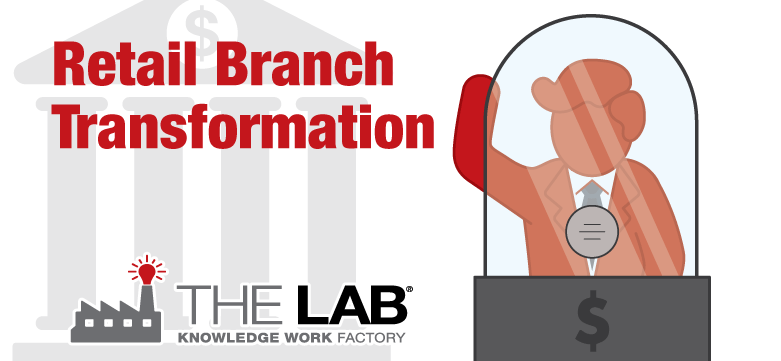Our previous case study centered around lean operations in a bank’s mortgage business. This case study is all about making a lean transformation in operations across the banking enterprise.
The bank in this story is the American division of a Top 3 bank in Canada. The operations that needed help spanned eight states across the northeastern U.S.—a network including 700 branches.
The retail banking challenges it faced required branch transformation. It had to adopt lean principles in banking. Competition was encroaching, in the form of larger money-center banks, electronic banking alternatives, and aggressive new upstarts: non-bank lenders.
Yet taking a lean banking approach to operations would be tricky. The bank was the product of several mergers. Which parts were lean? Which parts weren’t?
Leaning toward lean principles in bank branch transformation
This is precisely why a management team, helmed by the bank’s chairman, got in touch with The Lab. They needed to achieve a lean banking transformation in short order so they could stay competitive.
The scope of the assignment was massive. It covered:
- Ten-thousand employees.
- All 700 branches.
- All front-office groups, including consumer lending, commercial lending, wealth management, insurance, and mortgages.
- Back-office groups including deposit and loan operations.
- Support groups such as IT, finance, and HR.
It took The Lab eight weeks to analyze the situation. But we discovered a lot. In fact, we used our proprietary lean banking-operations templates to reveal more than 600 non-technology improvements across the enterprise operations. The resulting lean implementation plan included four valuable, counter-intuitive, and overlooked categories of improvement:
-
1. Lean banking principles target reductions in costly over-service in the branches
The bank’s 700 retail bank branches relied upon a sophisticated capacity planning model for staffing decisions. Perhaps it was too sophisticated for its own good. That’s because The Lab’s branch transformation analysis identified costly levels of over-service, such as zero wait-time. “No waiting in the teller line” may sound like a good thing, but the fact is that customers don’t place a terribly high value on it. In effect, the bank’s branches was over-serving, over-staffing, and over-spending. And it achieved zero competitive advantage for its effort.
-
2. A lean approach to branch transformation reduces sales-producer downtime
The key people charged with bringing new revenue into the bank—its vaunted sales force—were hampered. It’s like lean banking management had never come their way. Ad-hoc customization of offerings and terms were rife. Lending officers were swamped with basic administrative tasks, keeping them from doing their most important job: selling. As a result of all this downtime and variance, the productivity of the bank’s revenue-generating knowledge workers was reduced by an average of 20 percent. Every day. (Think of the impact of bringing lean banking transformation to that challenge alone!)
-
3. Lean transformation in banking comes to the back office
In some areas, The Lab discovered that up to 60 percent of organizational capacity was devoted to fixing errors. You read right: more than half of the knowledge workforce was spending its time correcting and completing inbound work products. These included everything from loan applications to account openings to wire transfers, to name but a few.
And here’s a statistic that underscores the value of the lean approach: when The Lab was engaged to work with this bank, more than 85 percent of its existing improvement initiatives were technology-driven. Yet more than 70 percent of the improvements we uncovered required no new technology whatsoever.
-
4. Support groups play a role in the lean financial services transformation
People often think of “support” as “the cost of doing business.” But these organizations can benefit from a lean approach. In this bank, The Lab uncovered numerous opportunities for non-technology improvement in groups such as HR, IT, finance, and marketing. Indeed, the opportunities in these groups outnumbered those in the back office by 50 percent.
Lean banking transformation results: Many happy returns
Without spending a dime on new technology, this bank was able to reap astonishing rewards from this lean transformation:
- Revenue-producer uptime increased by 30 percent.
- Branch service levels increased more than ten percent—all the more impressive considering that overall required headcount was reduced by more than 20 percent.
- Bank-wide operating costs dropped more than 15 percent.
The entire engagement self-funded in just four months. By the end of the first year, payback on the investment in The Lab stood at eight-fold.
Oh, and did we mention the overall savings, which recurred annually? They came in at over $80 million. Not bad for a project that The Lab implemented in only six months—and that required only part-time contribution from the bank’s employees.
The numbers in this lean banking case study are certainly staggering. But what’s even more staggering is the fact that they’re not unusual. The Lab achieves these kinds of results routinely. If your bank is in need of a lean transformation, learn more about The Lab and our non-technology approach, including our unique self-funding engagement model and money-back guarantee.
Real results. Real fast.
The Lab can get your first banking bot up and running in just weeks. It’s an irresistible offer, made all the more enticing by the fact that you don’t have to force this change on your workforce. Once they see it in action, they’ll be clamoring for more.
Call The Lab at (201) 526-1200 or email info@thelabconsulting.com today for your free, no-obligation 30-minute screen-sharing demo. You’ll love it!
For 2021: We have updated our bank client offering. Much of these findings and implementation results can be reviewed in the 3-part-series of “Big Rocks for Banks” below. Find out how to strategically lower costs, increase operating leverage, improve customer experience, and automate what previously wasn’t automatable in your bank.
Find them all here:





















